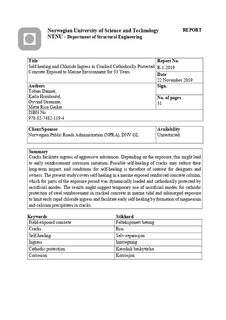Self-healing and Chloride Ingress in Cracked Cathodically Protected Concrete Exposed to Marine Environment for 33 Years
| dc.contributor.author | Danner, Tobias | |
| dc.contributor.author | Hornbostel, Karla | |
| dc.contributor.author | Strømme, Øyvind | |
| dc.contributor.author | Geiker, Mette Rica | |
| dc.date.accessioned | 2019-12-05T08:48:57Z | |
| dc.date.available | 2019-12-05T08:48:57Z | |
| dc.date.created | 2019-12-04T11:28:32Z | |
| dc.date.issued | 2019 | |
| dc.identifier.isbn | 978-82-7482-119-4 | |
| dc.identifier.uri | http://hdl.handle.net/11250/2631863 | |
| dc.description.abstract | Cracks facilitate ingress of aggressive substances. Depending on the exposure, this might lead to early reinforcement corrosion initiation. Possible self-healing of cracks may reduce their long-term impact, and conditions for self-healing is therefore of interest for designers and owners. The present study covers self-healing in a marine exposed reinforced concrete column, which for parts of the exposure period was dynamically loaded and cathodically protected by sacrificial anodes. The results might suggest temporary use of sacrificial anodes for cathodic protection of steel reinforcement in cracked concrete in marine tidal and submerged exposure to limit early rapid chloride ingress and facilitate early self-healing by formation of magnesium and calcium precipitates in cracks. | nb_NO |
| dc.language.iso | eng | nb_NO |
| dc.publisher | NTNU | nb_NO |
| dc.title | Self-healing and Chloride Ingress in Cracked Cathodically Protected Concrete Exposed to Marine Environment for 33 Years | nb_NO |
| dc.type | Research report | nb_NO |
| dc.description.version | acceptedVersion | nb_NO |
| dc.source.pagenumber | 31 | nb_NO |
| dc.identifier.cristin | 1756465 | |
| cristin.unitcode | 194,64,45,0 | |
| cristin.unitname | Institutt for konstruksjonsteknikk | |
| cristin.ispublished | true | |
| cristin.fulltext | postprint |
